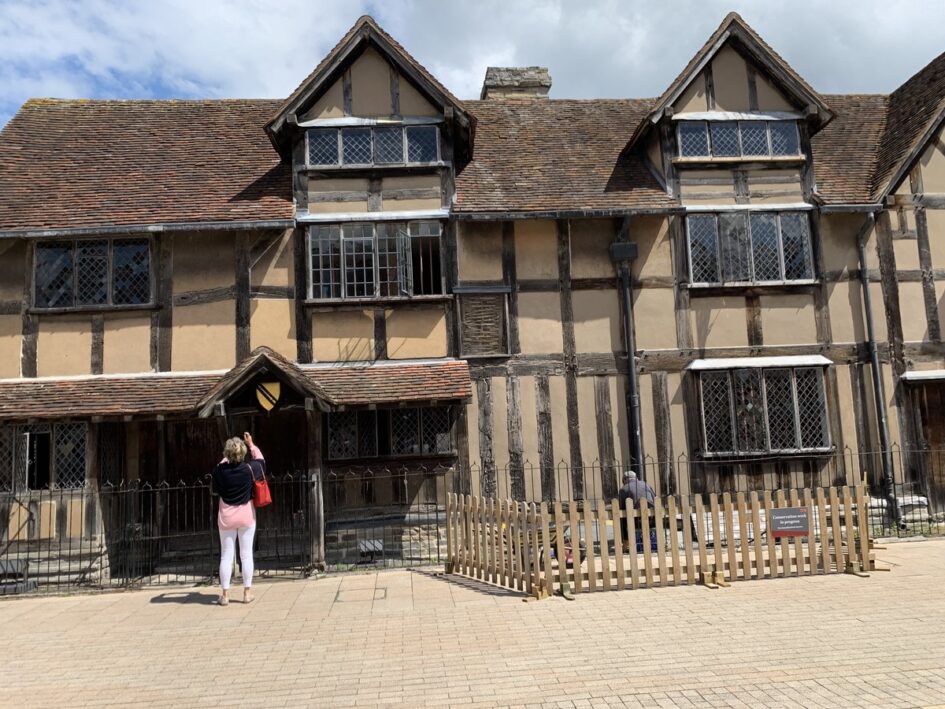I think I figured out why Stratford upon Avon is so famous. Towns or cities with 3 words in their names are extremely popular. Port-au-Prince. Rio de Janeiro. Salt Lake City. West Palm Beach. Also, Stratford upon Avon must have effective tourism marketing agencies.
I first heard about Stratford during college days, but not in my college. I used to spend my holidays at my cousin’s place in Bangalore. Pradeep and his friends were really cool. They had fought against parental pressure to become English Literature adventurers instead of doctors. I would hang around with Pradeep, Anu, Chandra and Nazarius among others, and listen intently while they talked animatedly about strange and baffling things. (At least they were strange and baffling to me.)
‘I am sure Stratford upon Avon would be just as you imagined it, just (a brief pause) as you like it.’ To which someone would respond, ‘Or it could be just (another pause) much ado about nothing.’ And then one of the guys would say, ‘We should also go to Windsor, heard the wives there are merry.’ Then they would all burst into laughter. And though I had no idea what the joke was, but not wanting to appear stupid in front of these illuminated souls, I too would join in the laughter. I should ask Pradeep to explain all this to me later, I would tell myself. But there was too much happening in Bangalore and I did not get the opportunity to find out what was happening in Stratford.
It was only recently that I had a chance to visit post-covid, post-Brexit England. One of the reasons for the trip – check out Stratford and find out what the fuss was all about. After a long, sleepless flight and probably a longer baggage-claim-wait at Heathrow, I took a train to Paddington Station and from there a few connecting trains to Stratford.
But upon arriving at upon-Avon, I had no idea where to go. Thankfully, a friendly taxi driver came to the rescue. Where are you from, he asked. When I told him India, he just took off without a word. I wondered briefly if he was taking me to the Little India part of town, where one could find Indian shops and restaurants, where one could eat a full thali meal complete with Stratford sambhar and Avon avail, served upon hot British Raj basmati rice.
But no, apparently there was another popular place that all Indian tourists went to. He took me to a quiet, quaint, cobble-stoned street. A little sign board said this was Henley Street. It was quiet because no traffic was allowed here, only pedestrians. And obviously a lot of pedestrians had heard about this place. It was full of excited people roaming purposefully up, down and across the street. They were tourists from all over the world, talking in hushed, reverent tones, pointing to this and that as they walked along. Not to be left out, I too decided to join the roaming crowd, though my roaming would be more aimless than purposeful.
But when I started walking, people turned to stare at me, looking rather annoyed. You see, I had come with baggage. I had stored my suitcases at Heathrow, but I was still lugging around a heavy travel bag. And this wheeled bag was going tak-a-tak-a-tak-a as it bumped along the cobblestones of quiet Henley Street. Considering the international nature of the people around me, I was probably being cursed at in various languages, from occidental to oriental. Including dialects of nations which the British empire thought were too poor to colonize. These people would probably go home and tell friends to watch out for this horrible Indian guy who disturbs the peace of Henley Street.
Putting on a brave face and ignoring the nasty looks of tourists around me, I ventured forth to find out a few Stratford secrets. Judging from gathered crowds, the most obvious attractions were a big old house, two statues, a few eateries and assorted gift shops.
The big old house stood high and mighty on one side of the street. But though the house looked grand from afar, when I walked nearer I noticed that roof tiles were discoloured, wooden boards were bent or cracked, window panes were broken. Traveling all this way to see a house in such disrepair? I could have seen plenty of old broken houses in India itself. But apparently the house was really special. Tourists were lining up to buy tickets to go inside. As I walked past, I heard them talking about what a thrill it was to see ‘William’s house’ in person.
But as though giving hope to all visitors, there was a middle aged maintenance man in overalls, repairing the house slowly but steadily. He was squatting and working behind a makeshift picket fence with a sign, ‘Conservation Work In Progress’. He was fighting single-handedly to reverse the ravages of nature, fixing whatever was broken, polishing dull to shiny, replacing old and collapsing with new and uplifting. Surely William would have approved.
The idea of ongoing repair was new to me, since I am used to the Great Indian Neglect. Thanks to the philosophy of use-till-collapse, we keep using and abusing our infrastructure till they fall down due to lack of maintenance. It’s hard to keep track of those countless buildings and constructions which have collapsed over the years. The Morbi bridge collapse in 2022 and more recently the Indore temple stepwell roof incident come to mind. And the potholes on Indian roadways will probably soon outnumber the stars twinkling over Indian skies.
But things were different in Stratford and there was no immediate danger of William’s house falling down. This probably explains the huge crowd standing in line outside. I think these people wanted to go in and see if the interiors were also being maintained well. I wondered if I should join the queue too. But then, all these visitors were probably quite familiar with William’s works and would be knowledgeable about all things displayed inside. But me, I would be among the lost and ignorant minority. I had heard William was in the performing arts, so the house must be full of miscellaneous drama/melodrama stuff.
So I did not go and see the interiors of William’s house. And of course regretted it later. (One more regret added to my long shoulda-coulda list.) After reaching India, I tried to find out more about William’s house using the most authentic source available to non-scholars, Wikipedia. Apparently the house was constructed with wattle and daub around a wooden frame, using oak from the nearby Forest of Arden. And now I had to add wattle and daub to my ‘Things I Know Nothing About’ list. Wikipedia also told me that William had neither built nor bought this house. He had inherited it from his father, who had been a glove maker. William’s father had apparently made money gloved-hand over fist.
I also learnt other things from Wikipedia. Apparently William proved that show biz was better than glove making. He returned to Stratford as London’s most successful drama king. And bought the town’s second biggest house in 1597 when he was just 33 years old. Known to fanas as New Place, the house had ten hearths, which meant it probably had between 20 to 30 rooms. Unfortunately New Place was destroyed over the years, and replaced by lesser houses.
So now, all roads in Stratford lead to Henley Street.
(to be continued)
April 23
Happy 459th Birthday, William








 Users Today : 6
Users Today : 6
Leave a Reply